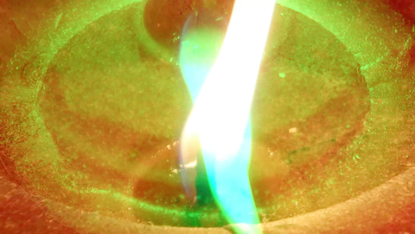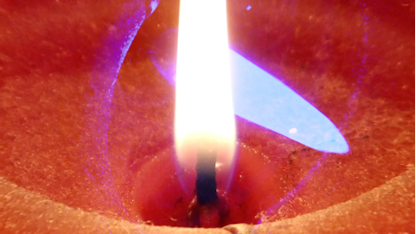"Time in Flames" - Audiovisual Composition
- Umut Yelbaşı

- Mar 30, 2024
- 4 min read
PROJECT DETAILS
Date: September-December 2023
Location: Glasgow, Scotland
Tasked with creating an audiovisual piece and writing a critical commentary on it, the video below is my submission.
I've used various techniques including overlaying and colour manipulation.
Video:
Critical Commentary:
Time in Flames
Time in Flames is an audiovisual composition made up of self-recorded, separate video and audio sources, created with the intention of viewing as an individual piece. The playback incorporates stereo audio and panning, and therefore is suitable for speaker or headphone use. All sounds and videos used have been recorded for the purposes of the composition.
Production & Inspiration
With a background in creative video editing using Premiere Pro, I’ve been interested in experimenting with blend modes. I was aware that the Screen mode could produce interesting blending effects between two consecutive graphic layers, which, along with simple opacity automation, is what the edit mainly revolves around.
Below is how the official Adobe documentation describes the Screen mode:
“Multiplies the complements of the channel values, and then takes the complement of the result. The result color is never darker than either input colour. Using the Screen mode is similar to projecting multiple photographic slides simultaneously onto a single screen.”
The Screen mode allowed me to create an effect akin to double-exposure photography, which incorporates a subject inside another subject, seamlessly merging the two images together. The frames above from the sequence that starts on the 37thsecond and goes on until 3 minutes 33 seconds in are good examples of points where the Screen mode is used to represent interconnectivity, and interaction. The two clips represent different people with different personalities, sometimes aligning and sometimes not, often times moving (or living) at different paces.
The same blend mode allowed the creation of the image below where the flame of a candle seems to be burning inside a guitar.

For the frame above, the guitar clip was lined up so that the flame would sit between two strings both because it makes sense visually, but also as a suggestion that the moving string affects the flame as it vibrates – in the context of the message of the composition, this can be interpreted as outside forces affecting a life.
The overall goal of the audio-visual composition is to be an expression of the “journey of life”. To do this, several imageries are used – the candle flame that the busy street clips are overlaid on top of signifies human life, a finite, volatile state of existence which ends suddenly.
The busy street going in four different directions is the world around the subject, happening all at once without waiting. This image was made by rotating and flipping four copies of the original clip, placing them as a 2x2 grid, and adding and automating the Relief feature of the Emboss effect. The regular purpose of this effect is to give depth by sharpening the edges of objects in the clip. For the composition, I’ve used it to not only sharpen the edges but to clone and separate a layer from the original clip, which ended up creating visuals that resemble the patterns in a Rorschach test.
With the very first sound on the video being a Shepard scale – an endlessly rising sequence that defies time – the timeless existence before life is shown. The overlaid flames in different (and constantly changing) colours are meant to signify the other lives that cross our paths, some change, some go through quicker than others, and some stay with us.
This was translated into visuals through the speed at which the different flames rotate, and their changing colours. While the first inverted flame spins at a rate of 30 degrees per 2 frames, the second inverted flame has a spin rate of 60 degrees per 2 frames – this was a conscious choice that predicts and accompanies the accelerating transitions and rhythm of the piece.
The main video of the burning candle is originally an 8-minute, 3840 x 2160 25fps video. The shots of the candle alone are almost completely untouched, apart from zooming in or masking the clip. For the overlaid clips with changing colours, Premiere Pro’s ASC CDL effect was used, which stands for American Society of Cinematographers Color Decision List and is used to standardise “the exchange of primary colour information.” (Adobe, 2023) Through the use of this effect I was able to manipulate the colours of the clips into other primary colours, and paired with being overlaid on the unchanged clip, this created dimension.
The “flame through the guitar” imagery was mentioned earlier. This is a key aspect of the composition as it’s both the shot that the rest of the composition builds upon, and technically the specific point that the Screen blending mode is utilised most successfully. The shot from 03:13 to 03:30 is four shots stacked on top of each other and is also the climax of the first part of the composition. The effect is great at removing the black parts of a clip that’s on top of another clip, which is exactly what happened here – the dark background is almost completely removed, allowing just the red candle and the flame itself to be visible from the guitar’s sound hole.
Reflection
By trying to limit the number of different clips used, and instead attempting to focus on how to manipulate the limited number of clips I had recorded to get a varied enough result, my challenge was with challenging my ability and knowledge of Adobe Premiere Pro, the video editing software the composition was created on. As previously mentioned, I was interested in experimenting with the video effects, which is what I did, and ended up with some unexpected results through methods I wasn’t anticipating. The colour emboss effect is one of these effects, which is something I had been avoiding due to a misguided prejudice of thinking of the effect as an outdated gimmick. Once I did some research on its uses and methods, I decided that it would be a good way of showing depth and abstractness, and it worked.
Overall, the composition reached the point that I was trying to take it to in terms of its symbolism, plot and visuals.
References
Adobe (2023) Color correction effects, Adjust and correct color in Premiere Pro CC. Available at: https://helpx.adobe.com/premiere-pro/using/color-correction-adjustment.html (Accessed: 12 December 2023).




